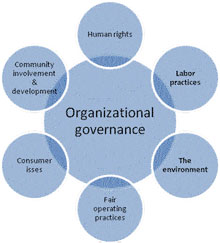

Figure 1
The standard provides guidance only and does not contain requirements. The word “shall” was purposely omitted from the document. ISO 26000 is not a management system standard and is not intended for third-party certification, regulatory or contractual use. The standard also states that it is, “not intended to provide a basis for legal actions, complaints, defenses or claims in any international, domestic or other proceedings, nor is it intended to be cited as evidence of the evolution of customary international law.”
Although the standard is not these things, EHS pros should understand its content and support its use. Understanding the standard is important because the document may serve as an initiative to establish social responsibility requirements from other sources. For example, The Global Reporting Initiative™, currently used by more than 1,500 organizations from 60 countries to report their sustainability (triple bottom line) activity, is updating its reporting process to include measurements on promotion of gender equality and empowerment of women, which is a social responsibility activity identified in ISO 26000.
The core subjects within ISO 26000 are shown in Figure 1. These core subjects should be viewed holistically and are interdependent. Each core subject contains 4-8 issues. The issues for labor practices and the environment are shown below Figure 1.
Labor Practices – Issues
1. Employment and employment relationships
2. Conditions of work and social protection
3. Social dialog
4. Health and safety at work
5. Human development and training in the workplace
The Environment - Issues
1. Prevention of pollution
2. Sustainable resource use
3. Climate change mitigation and adaptation
4. Protection and restoration of the natural environment
Health and safety at work
The health and safety at work issue contains many of the common best practice actions and expectations of a socially responsible organization. These actions include an occupational health and safety policy; application of the hierarchy of controls (e.g. engineering control before PPE); the analysis risks; providing equipment and PPE to prevent incidents; training; investigation and documentation of incidents; communication; and, actions for joint labor and management health and safety committees. Many of these actions may be met through compliance with state or federal OSHA requirements or conformance with health and safety management systems such as ANSI Z10.A few of the health and safety actions within ISO 26000 may prove challenging to U.S. organizations. For example, the standard says socially responsible organizations should “address the specific and sometimes different ways in which women and men are affected by occupational safety and health risks, and workers under particular circumstances such as people with disabilities, inexperienced or younger workers, pregnant workers and workers who have recently given birth or are breastfeeding.” Another uncommon health and safety action for U.S. organizations is the guidance that organizations should “strive to eliminate psychosocial hazards in the workplace, which contribute or lead to stress and illness.”
There are no state or federal OSHA requirements specific to pregnant workers and guidance on this topic is lacking in safety and health management systems such as OSHA VPP and ANSI Z10. Psychosocial hazards meet these same criteria. Employers in Europe, however, address these hazards through various laws. Organizations in Europe, therefore, may find it easier to achieve socially responsible health and safety at work guidance compared with U.S.-based organizations.
Interdependence
Although EHS pros may be comfortable with health and safety at work or pollution prevention issues, they should understand the entire contents of ISO 26000 to help appreciate the interdependence among all core subjects and issues. In addition to the issues for labor practices and the environment there are 27 other social responsibility issues to consider.An example of interdependence on activities can be found with psychosocial hazards. The root cause for many psychosocial hazards at work evolve from concerns that arise outside the work environment such as an impending divorce, heavy debt, illness in the family, lack of education, lack of transferable jobs skills, discrimination, and work-life balance. Various issues and actions within ISO 26000 address these topics.
Review and monitor
Although third-party certification for conformance with ISO 26000 is not intended and would be inappropriate, the standard contains clause(s) for an organization to review and monitor its performance on social responsibility. The standard discusses methods that may be used to measure performance.ISO 26000 cautions “that social responsibility is about more than specific achievements in measurable activities, such as reducing pollution and responding to complaints.” Social responsibility is based on values and attitudes. Therefore, monitoring “may involve more subjective approaches such as interviewing, observing and other techniques for evaluating behavior and commitments.” Considering this guidance, some aspects of behavioral safety programs may be used to support and enhance an organization’s social responsibility activities.
